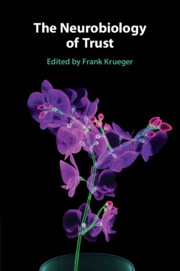Book contents
- The Neurobiology of Trust
- The Neurobiology of Trust
- Copyright page
- Dedication
- Contents
- Figures
- Tables
- Contributors
- Abbreviations
- Introduction
- Part I Fundamental Level of Trust
- Part II Neuropsychological Level of Trust
- Part III Neurocharacteristic Level of Trust
- Chapter 9 Trust and Distrust
- Chapter 10 Trust and Reciprocity
- Chapter 11 Trust and Demographics
- Chapter 12 Trust and Brain Dynamics
- Part IV Neuromolecular Level of Trust
- Part V Neuropathological Level of Trust
- Index
- References
Chapter 12 - Trust and Brain Dynamics
Insights from Task-Based and Task-Free Neuroimaging Investigations
from Part III - Neurocharacteristic Level of Trust
Published online by Cambridge University Press: 09 December 2021
- The Neurobiology of Trust
- The Neurobiology of Trust
- Copyright page
- Dedication
- Contents
- Figures
- Tables
- Contributors
- Abbreviations
- Introduction
- Part I Fundamental Level of Trust
- Part II Neuropsychological Level of Trust
- Part III Neurocharacteristic Level of Trust
- Chapter 9 Trust and Distrust
- Chapter 10 Trust and Reciprocity
- Chapter 11 Trust and Demographics
- Chapter 12 Trust and Brain Dynamics
- Part IV Neuromolecular Level of Trust
- Part V Neuropathological Level of Trust
- Index
- References
Summary
Interpersonal trust is a vital element in the social functioning of our relationships with persons, groups, and organizations. In the past two decades, an increase in task-based and task-free (resting-state) functional magnetic resonance imaging (fMRI) studies have been observed that explored the neuropsychological signatures of trust. In this book chapter, we compared the commonalities and differences between task-based fMRI (tb-fMRI) and task-free fMRI (tf-fMRI) approaches for studying trust and explored how these two approaches can make unique contributions to our understanding of the psychoneurobiological underpinnings of trust. Overlapping brain regions for both approaches have been identified in large-scale domain-general networks – reward (e.g., ventral striatum), salience (e.g., anterior insula), executive-control (i.e., lateral prefrontal cortex), and default-mode (i.e., temporoparietal junction) networks – supporting the underlying motivational, affective, and cognitive aspects of trust. While task-based research investigates dominantly those brain networks in building trust over time at the group level, task-free trust research has identified those networks in predicting trust preferences at the individual level. Future research would benefit from a combination of these two approaches for a broader understanding of the driving psychoneurobiological mechanisms of trust.
Keywords
- Type
- Chapter
- Information
- The Neurobiology of Trust , pp. 293 - 312Publisher: Cambridge University PressPrint publication year: 2021



